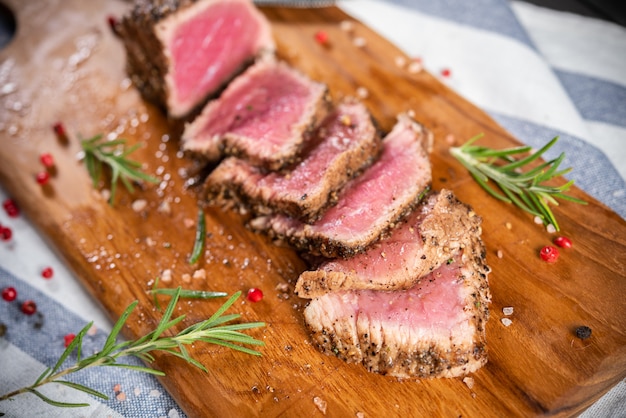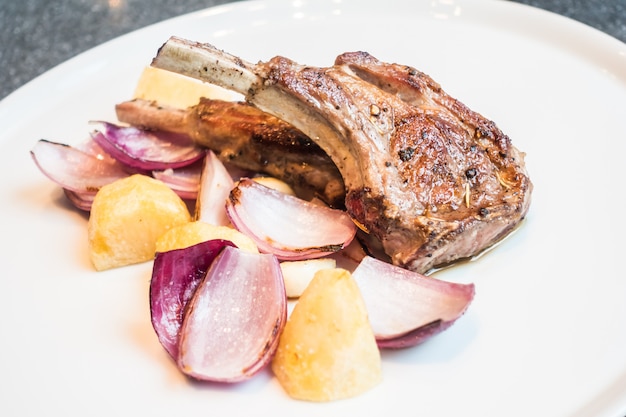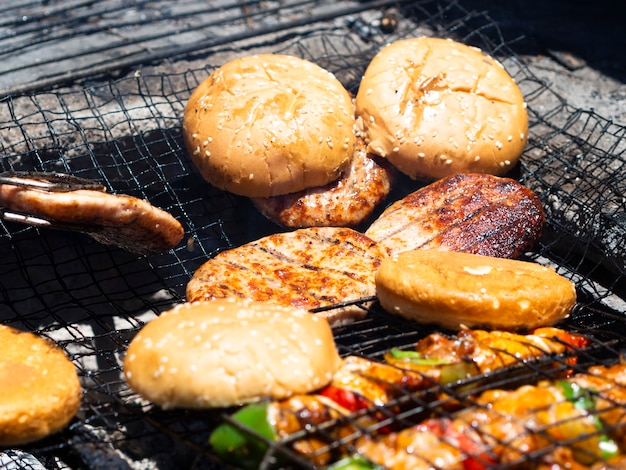Let's talk pork tenderloin, a real gem in the culinary world. It's so versatile, juicy, and incredibly tender – perfect for a quick weeknight meal or a fancy dinner party. But getting it right can be a bit tricky. Overcook it, and you're left with a dry, disappointing piece of meat. Undercook it, and well, nobody wants to deal with food poisoning.
That's where I come in! I've spent years perfecting my pork tenderloin game, and I'm here to share my secrets with you. We'll cover everything from choosing the right cut to mastering the perfect internal temperature, leaving you with juicy, flavour-packed pork tenderloin every time. Buckle up, it's going to be a delicious journey!
(Part 1) Choosing the Right Pork Tenderloin: The Foundation of Flavor

You can't expect a masterpiece without the right ingredients, and that's especially true for pork tenderloin. I'm a firm believer in fresh, high-quality meat, so I always head to my local butcher. They're absolute experts and can steer you towards the perfect cut for your needs.
Look for a Tenderloin That’s Firm and Uniform
A good pork tenderloin should be firm to the touch, not mushy or overly soft. It should have a nice, even colour, free from any discolouration or odd smells. While a bit of fat marbling is a good thing, adding flavour and keeping the meat juicy, avoid cuts that are overly fatty. You want a tenderloin that's lean and evenly textured.
Ask the Butcher for Help
Don't be shy about asking the butcher for advice. They can tell you which cuts are best suited for your chosen cooking method, and they can even provide tips on preparing the tenderloin for optimal results. For example, if you're planning on roasting your tenderloin, you might ask for a piece that's already been tied, which helps it cook evenly and beautifully.
Understanding the Different Cuts
There are actually two main types of pork tenderloins you'll encounter: center-cut and end-cut. The center-cut, as the name suggests, is taken from the middle of the loin and tends to be more tender and flavorful. End-cuts come from the ends of the loin and may be slightly tougher. However, end-cuts are generally less expensive, so they're a good option if you're on a budget. Don't be afraid to experiment and see which cut you prefer.
(Part 2) Getting Ready for Cooking: The Pre-Game Ritual

Alright, you've got your perfect pork tenderloin, so now it's time to prepare it for its culinary journey. This is where the real fun begins, and I'm excited to share my favourite tricks.
Seasoning is Key
Start by patting the tenderloin dry with paper towels. We want to remove any excess moisture that could prevent a nice crust from forming. Then, it's time for the flavour! While I'm a classic salt and pepper purist, feel free to get creative. Rosemary, thyme, garlic powder, smoked paprika – the possibilities are endless! But remember, less is more. A light hand with seasoning allows the natural pork flavour to shine.
Don't Overcrowd the Pan
When it comes to cooking your tenderloin, I like to keep things simple. You can use a cast iron skillet, a baking dish, or even the grill. Whatever your preference, make sure your pan or dish is large enough to allow the tenderloin to cook evenly. Don't overcrowd the pan! Cramming it in there will prevent the meat from browning properly and result in uneven cooking.
(Part 3) Understanding pork cooking temperatures: The Safety Net

Now, let's talk about the crucial aspect of pork tenderloin cooking – internal temperature. This is where things get serious, folks. The old days of pork being cooked to a well-done, dry state are long gone. We're all about that juicy, pink center now, but we still need to ensure it's safe to eat.
The USDA Recommended Temperature for Pork
The United States Department of Agriculture (USDA) recommends cooking pork to an internal temperature of 145°F (63°C), then letting it rest for three minutes before carving. This ensures that any harmful bacteria are eliminated while still allowing the meat to retain its tenderness and juicy goodness.
Don't Overcook It
Overcooking is a real danger, especially with a delicate cut like pork tenderloin. The goal is to achieve the safe internal temperature without drying out the meat. That's why I always use a meat thermometer – it's my trusty companion in the kitchen! You need one too! It's your safety net, allowing you to monitor the internal temperature precisely and avoid overcooking disasters.
(Part 4) Cooking Methods for Pork Tenderloin: Exploring the Possibilities
Alright, you've got your seasoned tenderloin, your trusty meat thermometer at the ready, and you're ready to cook! Let's explore some of the best cooking methods for this versatile cut of meat.
Pan-Seared Pork Tenderloin: Quick and Easy Delights
This is my go-to method for a quick and easy weeknight dinner. Simply sear the tenderloin in a hot pan, preferably cast iron, until it's nicely browned on all sides. Then, transfer it to a preheated oven to finish cooking. You can add some butter and fresh herbs to the pan for extra flavour. Remember, that thermometer is your best friend! It'll guide you to perfection.
roasted pork tenderloin: Elegance and Flavor
For a more impressive presentation, try roasting your tenderloin. Preheat your oven to 400°F (200°C) and place the tenderloin in a roasting pan. Baste it with a mixture of butter, garlic, and your favourite herbs for added flavour. As always, check the internal temperature with your thermometer – it's the key to success.
Grilled Pork Tenderloin: Smoky Flavor, Outdoor Delight
If you're feeling adventurous, try grilling your tenderloin. Heat your grill to medium-high heat, and then sear the tenderloin for a few minutes on each side. Close the lid and cook until the internal temperature reaches 145°F (63°C). For an extra smoky flavour, add some wood chips to the grill, like hickory or applewood. Just remember, grilling can be a bit unpredictable, so keep a close eye on your tenderloin and use that thermometer!
(Part 5) Resting is Essential: A Key to Juicy Results
You might think you're done once the tenderloin reaches the desired temperature. But hold your horses! Resting is crucial for juicy, delicious results. Let the tenderloin rest for 10-15 minutes before slicing and serving. This allows the juices to redistribute throughout the meat, resulting in a tender and flavorful masterpiece.
(Part 6) Serving Pork Tenderloin: A Celebration of Flavor
Now, the moment of truth! You've chosen the perfect tenderloin, you've cooked it to perfection, and it's had a good rest. It's time to enjoy your delicious creation!
side dishes and Sauces: The Perfect Companions
A well-cooked pork tenderloin deserves the best company. I love pairing it with roasted vegetables, creamy mashed potatoes, or a simple green salad. And let's not forget about the sauce. A rich pan sauce, a tangy cranberry sauce, or a classic gravy – the possibilities are endless!
Leftover Love: Turning Leftovers into Culinary Treasures
And let's be honest, there's nothing better than leftover pork tenderloin. It's fantastic in salads, sandwiches, or even just reheated with some gravy. You can even dice it up and add it to a stir-fry for a delicious and easy meal. Leftover pork tenderloin is incredibly versatile, so don't waste it!
(Part 7) FAQs: Addressing Your Culinary Curiosities
I'm sure you've got questions, so here are a few common ones, along with my answers.
Q1: How long does it take to cook a pork tenderloin?
The cooking time for a pork tenderloin depends on its size and the cooking method you choose. A small tenderloin can cook in as little as 20 minutes, while a larger one might take 45 minutes. It's best to use a meat thermometer to ensure it's cooked to the right internal temperature. Remember, the time isn't the key factor, but rather the internal temperature reaching 145°F (63°C).
Q2: Can I cook a pork tenderloin from frozen?
It's not recommended to cook a pork tenderloin from frozen. The meat will be unevenly cooked and may not reach the safe internal temperature. It's best to defrost it in the refrigerator overnight before cooking. This ensures that the meat thaws evenly, allowing for safe and consistent cooking.
Q3: What are the signs of overcooked pork tenderloin?
Overcooked pork tenderloin will be dry, tough, and pale in colour. It will also lose its juicy texture and taste. If you're unsure, check the internal temperature. If it's over 145°F (63°C), it's overcooked.
Q4: How do I store leftover pork tenderloin?
Store leftover pork tenderloin in an airtight container in the refrigerator for up to 3-4 days. You can also freeze it for up to 2-3 months. Remember, proper storage is key to maintaining the quality and freshness of your delicious leftovers.
Q5: What are some creative ways to use leftover pork tenderloin?
Leftover pork tenderloin is incredibly versatile. It can be sliced and added to salads, sandwiches, and stir-fries. You can also dice it and make a delicious pork tenderloin soup. It’s perfect for a quick and easy meal. Don't limit yourself! Get creative and use leftover pork tenderloin to add flavour to a variety of dishes.
(Part 8) Final Thoughts: A Delicious Conclusion
So there you have it! A complete guide to pork tenderloin cooking temperatures. I hope you found this helpful and informative. Remember, cooking pork tenderloin is all about finding the right balance between safety and flavour. Choose a good cut, season it well, and cook it to the right internal temperature, and you'll be rewarded with a delicious, juicy, and tender dish that will impress your family and friends. Happy cooking, and don't forget to let me know how it turns out!
Everyone is watching

Prime Rib Roast Cooking Time Chart: Per Pound Guide
Cooking TipsPrime rib roast. Just the name conjures images of lavish dinners, crackling fires, and hearty laughter. It’s ...

How Long to Bake Potatoes in the Oven (Perfect Every Time)
Cooking TipsBaked potatoes are a staple in my kitchen. They're incredibly versatile, delicious, and surprisingly easy to m...

Perfect Rice Every Time: The Ultimate Guide to Cooking Rice
Cooking TipsAs a self-proclaimed foodie, I've always been a bit obsessed with rice. It's the foundation of countless cuisi...

The Ultimate Guide to Cooking Asparagus: Tips, Techniques, and Recipes
Cooking TipsAsparagus. The mere mention of this spring delicacy conjures up images of vibrant green spears, crisp and burs...

Ultimate Guide to Cooking the Perfect Thanksgiving Turkey
Cooking TipsThanksgiving. Just the word conjures up images of overflowing tables laden with delicious food, the scent of r...
